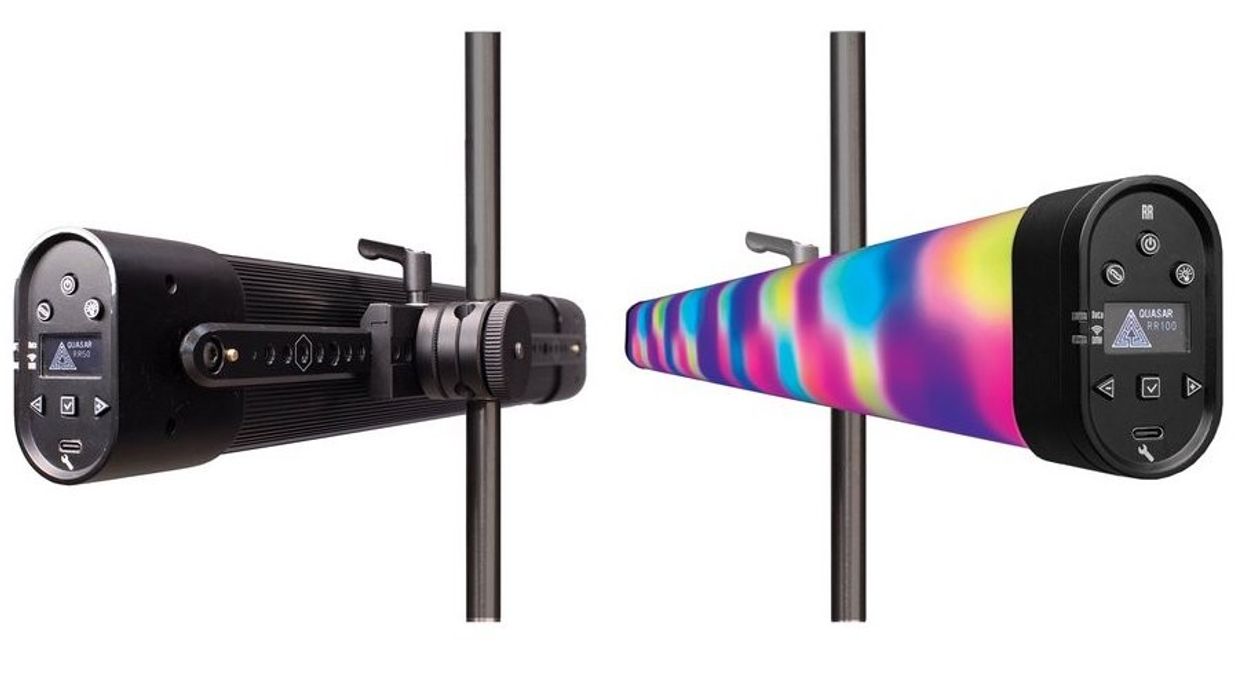Quasar Goes for the Double Rainbow with These New LED Lamps
Quasar Science has doubled the width and increased the pixel count on their popular LED linear lighting units.

Quasar Science, the Los Angeles based linear lighting powerhouse, has just released their newest RR units, which are similar to the original and very popular Rainbow units in terms of its narrow form factor but are twice as wide. This means you get twice as much light output, but even more exciting than that is you get even more individually controllable color pixels to work with for creating color effects.
If you haven't worked much with RGB LED units, you might be asking what these pixels are.
With these lights, individual parts can be controlled. So, you can have a light that is orange at one end of the tube and pink at the other. The more pixels, the more individual and fine the control you can create for the light. The new RR units have 24 pixels in the 23" model and 48 pixels in the 46" model. This is a major step forward versus the competition.
The RR units also now come out of the box with a rail rigging system designed in collaboration with key grip Chuck Smallwood to make it as easy as possible to mount the lights where you want them without requiring the purchase of extra accessories.
The rail runs the full back of the light, and includes 1/4" -20 and 3/8 threaded mounted points for attaching pins, and also allows for a Qs slider unit to position the mount precisely where you want it. All of that is included in the box.
Along with all that they have also rolled out new Q50R2 units, which has a whopping 24 individual pixels for the 4' model and is available in an 8' model with 48 pixels.
These units also get another upgrade coming from the RR units, and that is wildly expanded external control. The original Rainbow units had built-in LumenRadio for control, but the new units, R2 and RR, can be controlled with RDM, DMX over Cat5, ARTNET/sACN, and Wireless DMX CRMX by Lumenradio, Bluetooth + Wi-Fi.
These are truly units that should be able to fit into just about any workflow or setup without feeling frustrated or needing too many complicated and expensive adapters. Each pixel can be grouped together to be a single channel or form its own DMX channel (though the 48-pixel unit would take up a whole DMX universe with individual color controls).
On top of all that there is a new Swaptics light barrel that allows you to diffuse the light coming off the LEDs for a smoother light effect. You can also swap it out for a light magnifier projection lens that we are very curious to see in action.
One thing to note is that Quasar units don't run internal batteries. This is by design, since it both allows the units to be smaller and also allows for easier battery swaps. There isn't a linear LED tube with 12-hour batteries (yet), so it makes more sense to run out to an external battery that is easier to swap without having to re-rig your entire light. Quasar has a whole host of power solutions that are ever-expanding.
Tech Specs: RR Units
- RGBX 2000-6000K Crossfade White Light
- with RGB Color Mixing
- QS Pixel Control
- Manual Interface with OLED Screen
- Mounting Rail with 3/8-16 & 1/4-20 Threaded
- Output Enabled Button
- Universal AC Power 100v-240v - Auxiliary DC Input 10-26v
- Improved Low End Dimming - Finer Dimming Control
- Integrated Power Button
- Lead / Follow Mode
- Expanded Onboard Effects - Rig Mode
- RDM Enabled
- DMX over Cat5
- ARTNET/sACN
- Wireless DMX - CRMX by Lumenradio
- Bluetooth + Wi-Fi
Pricing and Availability
Here's a quick price breakdown for these lights:
Both are available now. Head on over to Quasar Science to learn more.
Source: Quasar Science
















